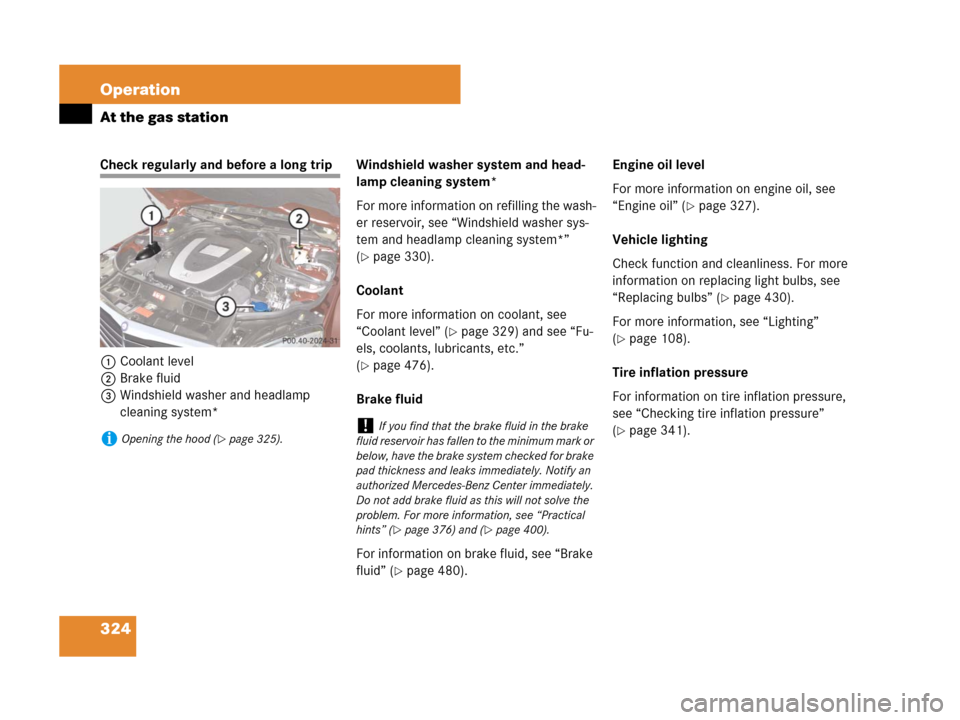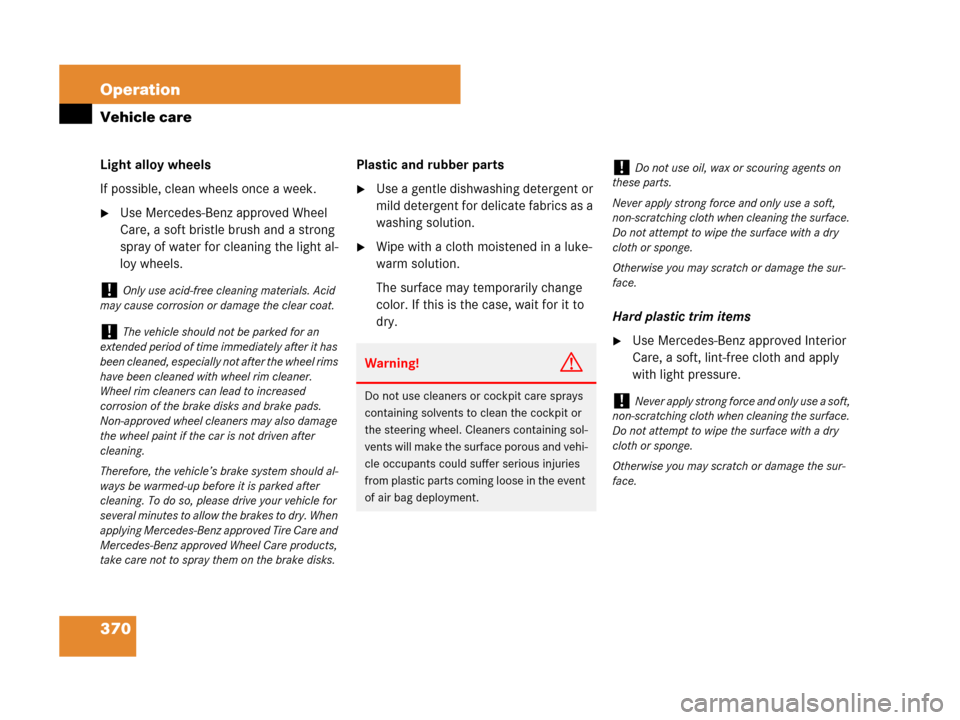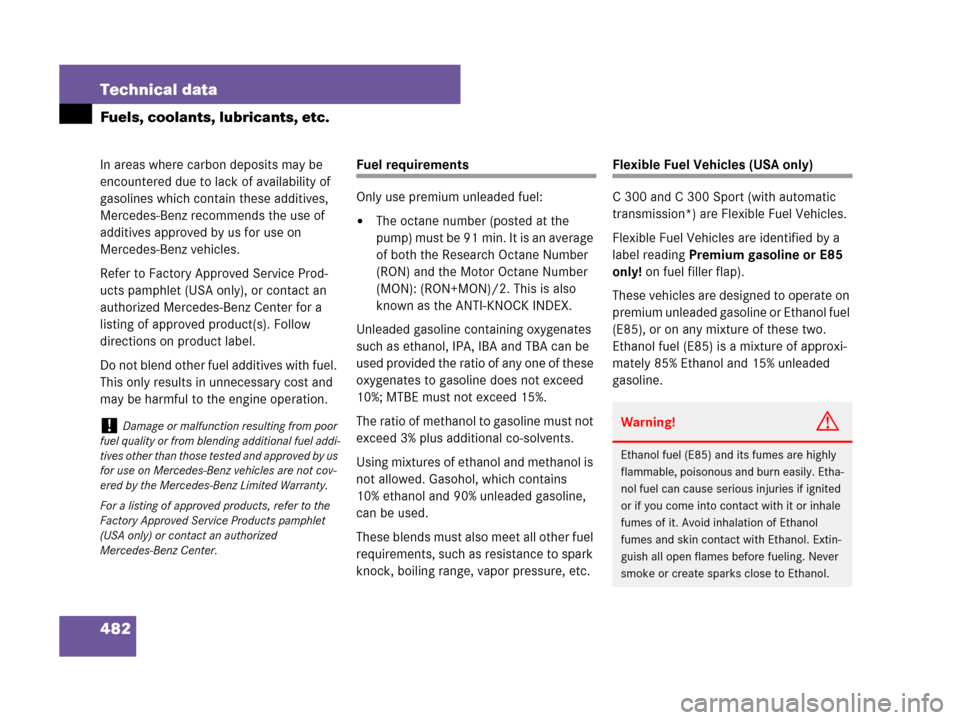Page 325 of 509

324 Operation
At the gas station
Check regularly and before a long trip
1Coolant level
2Brake fluid
3Windshield washer and headlamp
cleaning system*Windshield washer system and head-
lamp cleaning system*
For more information on refilling the wash-
er reservoir, see “Windshield washer sys-
tem and headlamp cleaning system*”
(
�page 330).
Coolant
For more information on coolant, see
“Coolant level” (
�page 329) and see “Fu-
els, coolants, lubricants, etc.”
(
�page 476).
Brake fluid
For information on brake fluid, see “Brake
fluid” (
�page 480).Engine oil level
For more information on engine oil, see
“Engine oil” (
�page 327).
Vehicle lighting
Check function and cleanliness. For more
information on replacing light bulbs, see
“Replacing bulbs” (
�page 430).
For more information, see “Lighting”
(
�page 108).
Tire inflation pressure
For information on tire inflation pressure,
see “Checking tire inflation pressure”
(
�page 341).iOpening the hood (�page 325).!If you find that the brake fluid in the brake
fluid reservoir has fallen to the minimum mark or
below, have the brake system checked for brake
pad thickness and leaks immediately. Notify an
authorized Mercedes-Benz Center immediately.
Do not add brake fluid as this will not solve the
problem. For more information, see “Practical
hints” (
�page 376) and (�page 400).
Page 371 of 509

370 Operation
Vehicle care
Light alloy wheels
If possible, clean wheels once a week.
�Use Mercedes-Benz approved Wheel
Care, a soft bristle brush and a strong
spray of water for cleaning the light al-
loy wheels.Plastic and rubber parts
�Use a gentle dishwashing detergent or
mild detergent for delicate fabrics as a
washing solution.
�Wipe with a cloth moistened in a luke-
warm solution.
The surface may temporarily change
color. If this is the case, wait for it to
dry.Hard plastic trim items
�Use Mercedes-Benz approved Interior
Care, a soft, lint-free cloth and apply
with light pressure.
!Only use acid-free cleaning materials. Acid
may cause corrosion or damage the clear coat.
!The vehicle should not be parked for an
extended period of time immediately after it has
been cleaned, especially not after the wheel rims
have been cleaned with wheel rim cleaner.
Wheel rim cleaners can lead to increased
corrosion of the brake disks and brake pads.
Non-approved wheel cleaners may also damage
the wheel paint if the car is not driven after
cleaning.
Therefore, the vehicle’s brake system should al-
ways be warmed-up before it is parked after
cleaning. To do so, please drive your vehicle for
several minutes to allow the brakes to dry. When
applying Mercedes-Benz approved Tire Care and
Mercedes-Benz approved Wheel Care products,
take care not to spray them on the brake disks.
Warning!G
Do not use cleaners or cockpit care sprays
containing solvents to clean the cockpit or
the steering wheel. Cleaners containing sol-
vents will make the surface porous and vehi-
cle occupants could suffer serious injuries
from plastic parts coming loose in the event
of air bag deployment.
!Do not use oil, wax or scouring agents on
these parts.
Never apply strong force and only use a soft,
non-scratching cloth when cleaning the surface.
Do not attempt to wipe the surface with a dry
cloth or sponge.
Otherwise you may scratch or damage the sur-
face.
!Never apply strong force and only use a soft,
non-scratching cloth when cleaning the surface.
Do not attempt to wipe the surface with a dry
cloth or sponge.
Otherwise you may scratch or damage the sur-
face.
Page 483 of 509

482 Technical data
Fuels, coolants, lubricants, etc.
In areas where carbon deposits may be
encountered due to lack of availability of
gasolines which contain these additives,
Mercedes-Benz recommends the use of
additives approved by us for use on
Mercedes-Benz vehicles.
Refer to Factory Approved Service Prod-
ucts pamphlet (USA only), or contact an
authorized Mercedes-Benz Center for a
listing of approved product(s). Follow
directions on product label.
Do not blend other fuel additives with fuel.
This only results in unnecessary cost and
may be harmful to the engine operation.Fuel requirements
Only use premium unleaded fuel:
�The octane number (posted at the
pump) must be 91 min. It is an average
of both the Research Octane Number
(RON) and the Motor Octane Number
(MON): (RON+MON)/2. This is also
known as the ANTI-KNOCK INDEX.
Unleaded gasoline containing oxygenates
such as ethanol, IPA, IBA and TBA can be
used provided the ratio of any one of these
oxygenates to gasoline does not exceed
10%; MTBE must not exceed 15%.
The ratio of methanol to gasoline must not
exceed 3% plus additional co-solvents.
Using mixtures of ethanol and methanol is
not allowed. Gasohol, which contains
10% ethanol and 90% unleaded gasoline,
can be used.
These blends must also meet all other fuel
requirements, such as resistance to spark
knock, boiling range, vapor pressure, etc.
Flexible Fuel Vehicles (USA only)
C 300 and C 300 Sport (with automatic
transmission*) are Flexible Fuel Vehicles.
Flexible Fuel Vehicles are identified by a
label reading Premium gasoline or E85
only! on fuel filler flap).
These vehicles are designed to operate on
premium unleaded gasoline or Ethanol fuel
(E85), or on any mixture of these two.
Ethanol fuel (E85) is a mixture of approxi-
mately 85% Ethanol and 15% unleaded
gasoline.
!Damage or malfunction resulting from poor
fuel quality or from blending additional fuel addi-
tives other than those tested and approved by us
for use on Mercedes-Benz vehicles are not cov-
ered by the Mercedes-Benz Limited Warranty.
For a listing of approved products, refer to the
Factory Approved Service Products pamphlet
(USA only) or contact an authorized
Mercedes-Benz Center.Warning!G
Ethanol fuel (E85) and its fumes are highly
flammable, poisonous and burn easily. Etha-
nol fuel can cause serious injuries if ignited
or if you come into contact with it or inhale
fumes of it. Avoid inhalation of Ethanol
fumes and skin contact with Ethanol. Extin-
guish all open flames before fueling. Never
smoke or create sparks close to Ethanol.